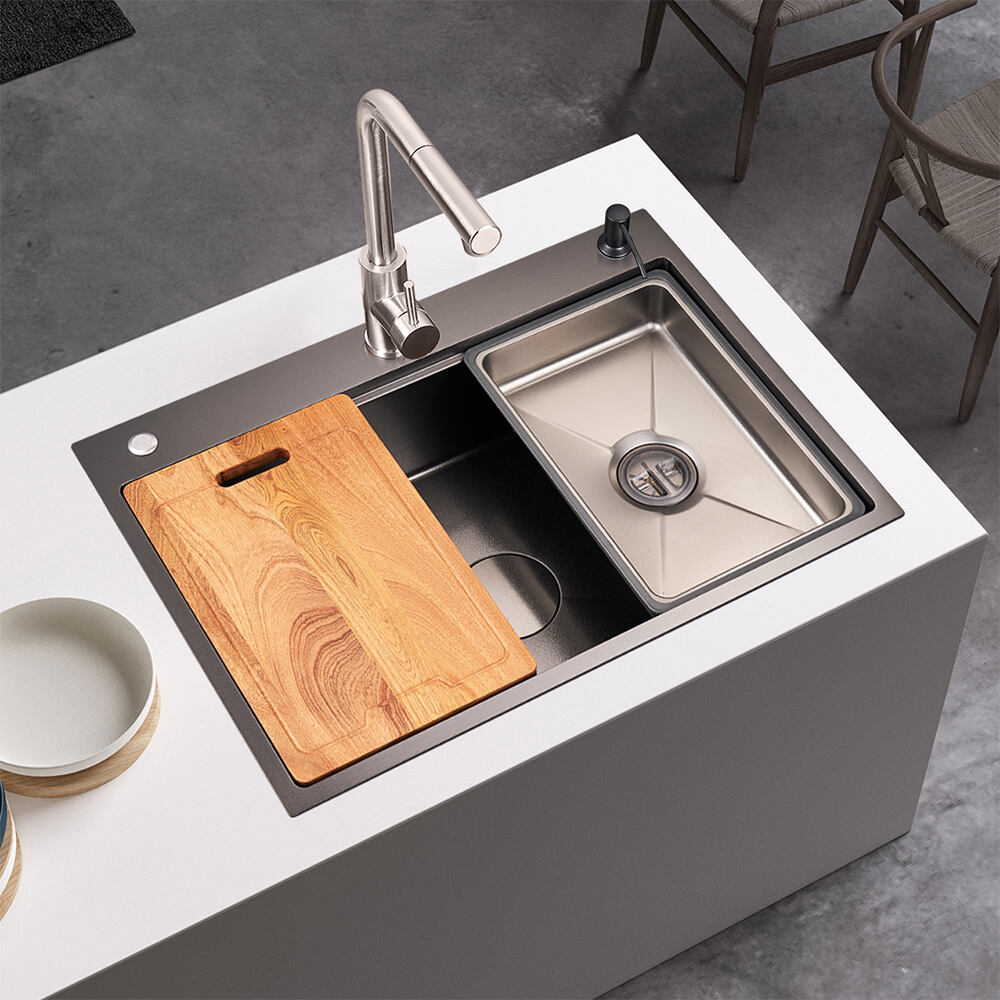Key Features to Consider When Choosing a Stainless Steel Sink
Choosing the right sink can significantly impact both the functionality and aesthetics of your kitchen. Among the various options available, the Stainless Steel Sink stands out as a preferred choice for many homeowners and designers. Known for its durability, ease of maintenance, and sleek appearance, this type of sink offers a combination of performance and style that suits a wide range of kitchen environments. Whether you are renovating your kitchen or setting up a new one, understanding the essential features of a high-quality Stainless Steel Sink will help you make a more informed decision that aligns with your lifestyle, cooking habits, and design preferences.
Material Thickness and Durability
Gauge Rating and What It Means
When assessing the durability of a Stainless Steel Sink, one of the first things to consider is its gauge rating. The gauge refers to the thickness of the stainless steel sheet used to fabricate the sink, and the lower the gauge number, the thicker the steel. Common gauges range from 16 to 22, with 16 and 18 gauge sinks being considered premium due to their superior strength and resistance to denting. A thicker Stainless Steel Sink not only handles the daily wear and tear more effectively but also helps to reduce noise caused by dishes, running water, or waste disposal units. While higher-gauge sinks are generally more affordable, investing in a lower-gauge, higher-quality sink often pays off in the long run through enhanced durability and performance.
Resistance to Corrosion and Stains
Another crucial factor in evaluating a Stainless Steel Sink is its resistance to corrosion and staining. High-quality sinks are typically made from 304-grade stainless steel, which contains chromium and nickel to enhance resistance against rust, oxidation, and chemical damage. This is particularly important in kitchens where the sink is frequently exposed to acidic foods, cleaning agents, or hard water. The longevity of a Stainless Steel Sink depends largely on its ability to withstand these harsh elements without developing unsightly discoloration or structural weaknesses. Opting for a sink with a polished or brushed finish can also help hide minor scratches and water spots, maintaining a clean and attractive appearance over time.

Design and Configuration
Number of Bowls and Their Utility
The bowl configuration is an essential aspect of sink design that affects both functionality and space utilization. Stainless Steel Sinks are available in various configurations, including single, double, and even triple bowl options. A single bowl sink provides more uninterrupted space for washing large pots and pans, making it ideal for smaller kitchens or minimalist designs. On the other hand, a double bowl sink offers flexibility for multitasking, such as washing on one side and rinsing or drying on the other. Some double bowl sinks feature uneven sizes, providing a specialized area for food prep or soaking utensils. Choosing the right bowl layout depends on your cooking style, dishwashing habits, and how often the sink will be used simultaneously by multiple people.
Mounting Style: Undermount vs. Topmount
The way a Stainless Steel Sink is installed also influences both appearance and ease of maintenance. The two primary mounting styles are undermount and topmount (also called drop-in) sinks. Undermount sinks are mounted beneath the countertop, creating a seamless look that is easy to clean, as debris can be swept directly into the sink without catching on edges. This makes them a popular choice for modern, high-end kitchen designs. Topmount sinks, while more traditional, are easier to install and often more budget-friendly. They have a visible rim that rests on the countertop, which may require more effort to keep clean but can offer additional support and ease of replacement. Selecting the right mounting style for your Stainless Steel Sink depends on your kitchen design, countertop material, and cleaning preferences.
Sound Insulation and Noise Control
Importance of Sound Dampening Pads
One of the common issues with Stainless Steel Sinks is the noise generated when water hits the metal or dishes clatter during washing. High-quality sinks often come with sound dampening features, such as rubber pads or undercoating materials applied to the underside of the sink. These pads help to absorb noise and reduce vibration, creating a quieter and more pleasant kitchen environment. The presence and quality of sound dampening technology are key indicators of a premium Stainless Steel Sink. Not only do they make everyday use more comfortable, but they also protect the cabinet area beneath the sink from moisture and condensation buildup caused by hot water or steam.
Effectiveness of Underside Coatings
In addition to pads, some Stainless Steel Sinks feature special coatings on the underside that serve both acoustic and thermal purposes. These coatings not only dampen sound but also prevent the sink from sweating due to temperature differences between the water and surrounding air. This is particularly useful in humid climates or during heavy usage when condensation can damage wooden cabinetry over time. A well-coated Stainless Steel Sink enhances both noise insulation and the long-term integrity of your kitchen setup. Checking for these hidden yet impactful features ensures that you are investing in a sink that performs well in both comfort and practicality.
Size, Depth, and Ergonomics
Matching Sink Size to Kitchen Layout
Choosing the right size for your Stainless Steel Sink is not just a matter of preference but also a critical factor in optimizing your kitchen’s workflow. The sink should be proportionate to your countertop space and aligned with your kitchen’s layout and cabinet structure. A sink that’s too large can dominate a small kitchen, while a sink that’s too small may not provide adequate space for washing larger cookware. Many homeowners prefer a 30 to 33-inch sink for standard kitchens, but custom sizes are also available to accommodate unique layouts. Carefully measuring your available space and considering how the sink will interact with nearby appliances and cabinets will ensure a seamless and ergonomic integration.
Ideal Depth for Daily Use
Sink depth plays a vital role in both convenience and comfort. Most Stainless Steel Sinks range from 7 to 10 inches deep, with deeper sinks offering more space for soaking and washing large items. However, excessively deep sinks may strain your back or make it difficult for shorter individuals to use them comfortably. Shallower sinks, while easier to access, may not contain splashes as effectively. Finding the right depth depends on how frequently you use the sink, the size of your typical dishware, and whether the sink will be used for heavy-duty cleaning tasks. A depth of 8 to 9 inches is often a practical compromise between capacity and ease of use, offering functionality without sacrificing comfort.
Finish and Aesthetic Compatibility
Types of Finishes Available
Stainless Steel Sinks come in various finishes, each affecting the sink's appearance and maintenance requirements. Brushed finishes are the most common, offering a soft, matte look that hides scratches and fingerprints well. Polished or mirror finishes provide a more reflective and modern aesthetic but require frequent cleaning to maintain their shine. Some manufacturers offer satin or textured finishes for enhanced resistance to water spots and easier upkeep. When selecting a finish, consider how it will match with your other kitchen elements, including appliances, cabinetry, and fixtures. The right finish enhances the visual harmony of your space while also contributing to a more practical and low-maintenance sink experience.
How Finish Affects Cleaning and Longevity
The finish of a Stainless Steel Sink doesn’t just affect how it looks; it also plays a role in how easy it is to maintain and how long it retains its appearance. Brushed finishes are particularly favored for their ability to mask everyday wear and tear, including light scratches and mineral deposits from hard water. Conversely, highly polished finishes, while striking, can show blemishes more readily and demand more attention to keep clean. Choosing the appropriate finish for your Stainless Steel Sink is a matter of balancing style preferences with your willingness to perform regular maintenance. Regardless of the finish, regular cleaning with mild detergent and soft cloths will help preserve the sink’s appearance and extend its lifespan.
Additional Features and Accessories
Integrated Drainboards and Workstations
Modern Stainless Steel Sinks are often designed with integrated features that enhance their functionality, such as drainboards or built-in workstation ledges. Drainboards provide a convenient area for drying dishes, washing vegetables, or organizing cooking tools. Some premium sinks come with accessories like cutting boards, drying racks, and colanders that fit perfectly within the sink, turning it into a multifunctional workspace. These features are especially useful in compact kitchens where counter space is limited. A Stainless Steel Sink with built-in accessories can streamline food preparation and clean-up, making it an invaluable component of an efficient kitchen design.
Compatibility with Garbage Disposals
If you plan to install a garbage disposal unit, it is essential to ensure that your chosen Stainless Steel Sink is compatible. Most high-quality sinks are designed with standard drain openings and robust construction to support the weight and vibration of a disposal system. However, confirming compatibility in advance can prevent installation issues and prolong the life of both the sink and the disposal unit. A strong, well-fitted sink can also reduce noise from the garbage disposal, improving the overall kitchen experience. Compatibility with accessories and appliances is a critical consideration that adds to the long-term convenience and adaptability of your Stainless Steel Sink.
FAQ
What is the best gauge for a Stainless Steel Sink?
The best gauge for a Stainless Steel Sink is typically 16 or 18, as these are thicker and more resistant to dents and noise.
How do I maintain the finish of a Stainless Steel Sink?
Clean it regularly with a soft cloth and mild detergent, and avoid using abrasive cleaners to preserve its appearance and finish.
Can I install a Stainless Steel Sink with any countertop?
Yes, but undermount sinks work best with solid surface countertops like granite or quartz for proper support and sealing.
Are Stainless Steel Sinks prone to scratching?
Minor scratches can occur over time, especially with polished finishes, but most brushed or satin finishes effectively hide them.



